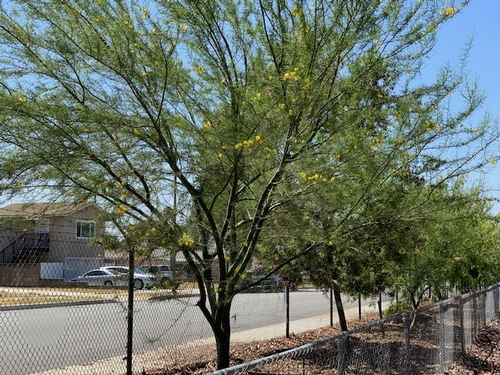- Author: Janet Hartin
In your landscape, your trees and edibles should come first under drought and water restrictions! If there just isn't enough water to go around, your lawn and flowers should be sacrificed instead. Trees are our most valuable landscape resource and take years to maximize their benefits (shade, cooling, habitat/ecosystem enhancement, carbon dioxide storage, energy conservation, pollution filters, etc.). 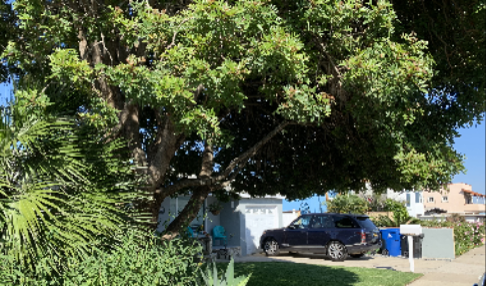
Just a few slow, deep waterings with a garden hose away from the trunk and slightly beyond the drip line will keep established trees alive, even during summer. Remember to keep trunks dry!
Here are some other tips:
• Spread and maintain 2-4” of mulch around garden plants and trees (3-4” for wood chips, 2” for pebbles, decomposed gravel, etc.) keeping it a few inches away from tree trunks. (Note: dark colored dyed mulches should be avoided in inland and desert areas due to their high surface temperatures that can > 60 degrees F hotter than living plants and lighter colored mulches.)
• Water early in the morning when soil evaporation is minimal.
• Control weeds. They compete with other plants for water.
• Avoid fertilizing. Nitrogen increases growth and the need for more water.
• Don't plant new plants during the summer when temperatures are highest. Even drought-resistant native and non-native plants need regular watering their first season.
- Author: Janet Hartin
During the drought, your trees should come first! Because many well-maintained trees don't reach their prime until their 4th or 5th decade, it's important to keep them watered during the drought and water restrictions. Older trees absorb higher levels of carbon dioxide, do a better job of cooling urban heat islands and providing shade. They also filter air and water pollutants, reduce soil and water erosion, provide habitat for wildlife, enhance privacy, beautify neighborhoods and parks, enhance property values, and even improve mental and emotional health. Trees are worth saving! The price of starting over is just too steep.
Recognizing early signs of drought stress is important because irreversible damage can occur that no amount of watering will correct. If you cash in your grass for a water district rebate, remember to water any trees that relied on water from the lawn sprinklers. This is because tree roots grow laterally quite a distance, often well beyond the dripline of the tree under the lawn. Over time, start watering them more deeply and less often to encourage deeper roots and enhanced stability.
Just a few deep waterings in mornings or late evenings with a garden hose during spring and summer can keep a tree alive, even during a drought. Keep the trunk dry and water from the mid-dripline outward. Apply a slow steady stream of water, moving the hose to another section of the tree every 1-2 hours. Another inexpensive way to water your trees is to encircle them with soaker hoses that connect to a garden hose. The soaker hose should be in concentric rings about one foot apart starting two feet away from the trunk for a larger tree, closer for a more recently planted tree with a more confined root system.
Check trees regularly for these common symptoms of water stress:
• Wilting or drooping leaves that don't return to normal by evening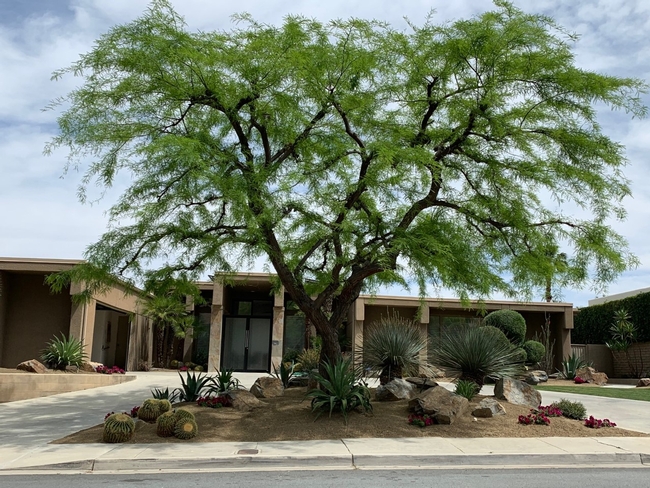
• Yellow, brown or sometimes gray leaves that may drop from the tree
• Small new foliage and stunted overall tree growth
Other ways to reduce tree water loss include:
• Keep weeds out (they compete for water
• Maintain a 3-4” of organic mulch or 2” layer of inorganic mulch (pebbles, decomposed gravel) around your trees, starting a few inches away from the trunk outward.
• Avoid fertilizing since that increases their water need.
• Do only necessary pruning (to remove dead wood and any dangerous limbs that look like they might fail) since this stresses the tree and can increase its water need.
--------------------------------------------
UC Resources at Your Fingertips:
Free Download Publications: https://anrcatalog.ucanr.edu
-Keeping Plants Alive Under Drought and Water Restrictions
-Sustainable Landscaping in California
-Lawn Watering Guide for California
-Use of Graywater in CA Landscapes -
CA Institute for Water Resources: http://ciwr.ucanr.edu/ (blogs, climate-smart ag, podcasts, etc.)
UC Cooperative Extension Master Gardener Program:
For more drought tips and help with your home gardening questions, contact a UCCE Master Gardener volunteer. Find your local program atucanr.edu/FindUs/
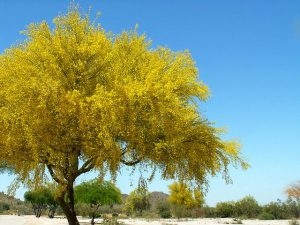
- Author: Janet Hartin
I hope all of you and your loved ones are staying well and healthy as the pandemic continues. Involving yourself in outdoor activities is not only a great way to escape 'cabin fever' and improve your physical health but it is also good for you psychologically, as well.
A silver lining for me over the past few months has been the opportunity to summarize results of some research studies including an update from a mulch trial that I'll report on virtually rather than live at the American Society for Horticultural Science conference (that was to be held in Orlando). I thought you might be interested in the results.
The objective of the research project was to measure the impacts of organic mulch treatments on the growth and health of four species of low maintenance, drought-tolerant landscape trees under deficit irrigation. Species selected were Parkinsonia x ‘Desert Museum' (it's thornless!); Chilopsis linearis ‘Bubba' (Desert Willow) (beautiful magenta flowers!), Pistacia ‘Red Push' (hybrid from P. atlantica and P. integerrima with brilliant orange fall foliage), and Prosopis glandulosa ‘Maverick' (thornless). Trees were planted in a randomized complete block experimental design in at the Chino Basin Water Conservation District (CBWCD) in Montclair in October, 2016. Half of the trees received 4” of organic mulch and half did not. Trees were transplanted from 15-gallon containers and irrigated with recycled water at 80 percent of reference evapotranspiration (ETo) the first 12 months.
Irrigation was reduced to 50% ETo in November, 2017 which was maintained until May 2020, when irrigation ceased. While the study continues through October 2020, there are some interesting early results. Organic mulch applications enhanced growth with no loss in quality in the Pistacia, Prosopis glandulosa, and Chilopsis linearis trees while growth was actually better in the Parkinsonia trees that did not receive mulch. This may be due to the fact that its trunk and branches actively photosynthesize as well as its leaves. Parkinsonia leaves also feature sunken guard cells, providing another form of drought avoidance. Furthermore, they develop deep root systems and may not need the added benefit of reduced soil evaporation in the top few inches of soil provided by the mulch. While all of the species selected have wonderful attributes, the Parkinsonia 'Desert Museum' has all the best traits of its palo verde heritage including having no thorns and a continues bloom throughout summer.
A huge thanks to our UCCE San Bernardino County Master Gardener team (led by Irene) who take data quarterly on the trees, recording trunk circumference at 6" and 3'. This is another great example of the breadth and depth of the contributions of our wonderful volunteers!
The four species of landscape trees in this study are part of a larger study at University of California, Riverside to determine the ability of 12 species of landscape trees to mitigate impacts of climate change. While I'll be long retired, growth and health data of all species will continue to be evaluated through at least 2035. The study at CBWCD provided the opportunity for a mulch/no mulch treatment for four of the most promising species which was space-limited at UCR.
Below are plot photos from October 2016 (right after planting), July 2020 (no irrigation for 3 months), a mature 'Desert Museum' tree in prolific bloom (photo credit to Dr. Bob Perry, Emeritus Professor, Cal Poly Pomona), and a mature Chilopsis linearis 'Bubba' from our UCR plot.
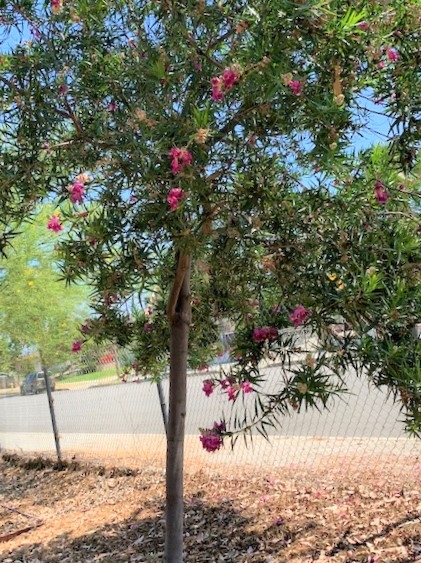
Save the date! We will be hosting a virtual UCR Field Day on September 3, 2020 featuring our drought-tolerant landscape plots at UC Riverside that was to be held live last May. More information is forthcoming but it will provide at least four hours of continuing education hours and a chance for you to ask questions of Dr's Amir Haghverdi, Don Merhaut and myself.
Have a wonderful August in your garden!
Janet

